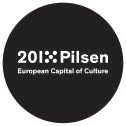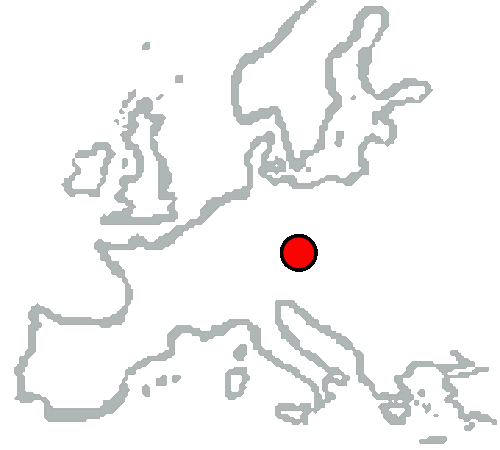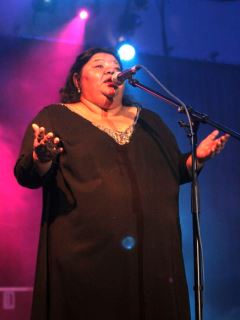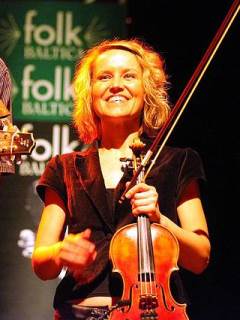FolkWorld #56 03/2015
© Wikipedia, the free encyclopedia
Pilsen, Open Up!

Africa Live, 12–30 April:
The festival Africa Live is dedicated to showing the culture, customs and the world of Africa to the Pilsen populace and, at the same time, commemorating the home country to African citizens living in Pilsen. The programme of the festival is aimed not only at adults, but also at younger audiences as it involves fairy tales for children, dance and drum workshops, a cooking school, lectures, film nights, concerts and dancing.
Bavarian Days, 20–26 April:
This one-week festival will present contemporary artists from Bavaria and projects of Bavarian-Czech cultural cooperation at various places in Pilsen. It will include performances by a world-famous boys' choir in the Cathedral, as well as rock musicians in local clubs. DEPO will host an exhibition of design, dance performances, authors’ readings, workshops for schools and programmes for families with children.
Festival Mediterránea 2015, 12–30 May:
The Festival Mediterránea aims to convey to Pilsen’s inhabitants the beauty and culture of Mediterranean countries, including but not limited to Spain and France. The Festival Mediterránea also offers an opportunity to become acquainted with a real Mediterranean market or to participate in the international dance competition Flamencopa within the framework of this festival.
Festival CIOFF, 3-8 June:
Since 1997, Pilsen has been a meeting place for lovers of folklore and folk art, each year attracting around twenty adult and children’s folklore groups from all over the Czech Republic and abroad, including participants from exotic countries. Since 2008, the festival has been a regular member of the prestigious worldwide organisation CIOFF®, acting under the framework of UNESCO.
The main festival events are supported by a rich accompanying programme, including dance workshops for the public, educational concerts for schools, performances for seniors, art competitions for children and much more.
Celebrations of Chodsko, 24–30 August:
Vavřinecká Fair, a.k.a. Celebrations of Chodsko, is the largest festival in Domažlice and the entire Chodsko region. Over five hundred performers from domestic and foreign folk ensembles alike will gather on five stages. Festival visitors can enjoy the folklore atmosphere with all its related attractions, as well as various musical and social genres associated with this jolly event.
In 2015, the city of Plzeň in western Bohemia in the Czech Republic,
known worldwide for its Pilsner beer, has been elected
as European Capital of Culture (www.plzen2015.cz),
together with the Belgian city of Mons
(www.mons2015.eu).[56]
 Czech Republic (Česká republika)
Czech Republic (Česká republika)
Capital: Prague
Population: 10.5 Mio.
Location:
The Czech Republic is a landlocked country in Central Europe bordered by Germany to the northwest and west, Austria to the south, Slovakia to the east and Poland to the northeast.
It includes the historical territories of Bohemia and Moravia, and Czech Silesia.
Music of the Czech Lands comprises the musical traditions of Bohemia, Moravia, and Czech Silesia. Music in this area has its roots in more than 1,000 year old sacred music. The oldest recorded song from Czech lands is the hymn "Lord, Have Mercy on Us", dating from the turn of 10/11th century.
Traditional and classical
The traditional music of Bohemia and Moravia has been well documented and influenced the work of composers like Leoš Janáček, Antonín Dvořák, Bedřich Smetana, and Bohuslav Martinů. Janáček made his recordings at an auspicious time. The 1880s saw the decline of traditional music; however, Janáček brought a Moravian string band to the 1895 Ethnographical Exhibition in Prague, which led to increased feelings of national pride and identity, and a resurgence in traditional music.
The most famous classical music pieces from Czech Republic include The New World Symphony from Dvořák, Má vlast from Smetana and Sinfonietta from Janáček. Some pieces of classical music have actually been made more famous than the composer himself, for example "Entrance of the Gladiators" by Julius Fučík, better known just as "the circus music". Through the centuries, Czech composers were usually heavily influenced by traditional music from their country, which can be seen especially when listening to Smetana. Although the most popular classical music from Czech Republic comes from the Romantic era, Classical and Baroque composers should not be overlooked. These composers include Adam Michna, Heinrich Biber, Jan Dismas Zelenka, Johann Wenzel Stamitz and Johann Ladislaus Dussek.
Undoubtedly the most internationally famous dance is Bohemian polka. Polka is a dance in duple time that became popular across Europe in the 19th century and spread across the world, influencing music from Mexico to Japan. Perhaps the most famous example is "Škoda lásky" ("Wasted Love") from 1927, better known under the name "Beer Barrel Polka". Czechs had a highly influential role in the development of Mexican cultural music. In the 1800s immigrants from Moravia were settling in the gulf coast area of Texas; many of them brought along polkas and waltzes which began to become popular with the Mexican people who lived among them. Love for these styles by the Mexican people later developed into Norteño and Tejano.
Bohemian traditional music is most innovative in Chodsko, where bagpipes are common. Moravian traditional music is best known for the cimbalom, which is played in ensembles that also include double bass, clarinet and violins. The traditional music of the regions of Moravia displays foreign influences, especially in Valachia which is tinged by Romanian and Ukrainian legacy and has close cultural relations with Slovakia and Lachia (the borderland of northern Moravia and Czech Silesia) with its Polish aspects.
Prague was well known for its pub songs called Staropražské písničky ("Old Prague Songs"), which are influenced by Viennese schrammelmusik and other forms. These songs are still played by bands like Šlapeto. A more modernized urban music is called tramp music (trampská hudba). Tramp music has been popular since its invention as part of the Czech tramping movement that began when early 20th-century city dwellers began seeking physical and imaginative respite from the pressures of urban life.

 Prosti Dumi @ FolkWorld:
FW#36
Prosti Dumi @ FolkWorld:
FW#36
Popular music
The 1960s saw American bluegrass music gain wide popularity, and the first European festival was held in 1972 (the Annual Banjo Jamboree in Kopidlno). In 1964 and 1982, Pete Seeger toured the country, inspiring generations of Czech bluegrass and American-style folk musicians. One notable example is the band Poutníci, whose early success helped perpetuate bluegrass music in the Czech Republic. Many former members of Poutníci have recorded or toured with the band Druhá Tráva, which has brought Czech bluegrass to the modern world music stage.
Czech folklore
Czech folklore is the folk tradition which has developed among the Czech people over a number of centuries. Czech folklore was influenced by a mix of Christian and pagan customs. Nowadays it is preserved and kept alive by various folklore ensembles uniting members of all ages, from children to seniors, showing their talent during competitions, folklore festivals or other performances.
The Czech Republic is divided into a number of ethnographic regions. Each of them has special folklore traditions, songs or costumes and specializes in different crafts. As a result, Czech folklore provides a diverse source of entertainment.
Music and dance
Music played an important part in life of common people or peasants in the Czech Republic. It offered both means of expression and a vent for their emotions. Resulting music varies not only by the region of its origin but also in the purpose of its use. Therefore, there are myriads of distinct folk songs.
Music often addressed everyday issues and was passed down orally. From the 19th century onward it was recorded by etnographs. Traditional celebrations such as welcome of the spring, successful harvest are still among the occasions traditionally celebrated with songs. More lively themes were used specifically during celebrations, weddings or feasts. Funerals and mournful occasions also had their own set of songs and tunes.
Songs and especially dance linked to conscription of young Czech boys called “verbuňk” in times of war has a particular place in Czech folklore and was listed by UNESCO in the List of the Intangible Cultural Heritage of Humanity.[1]
There are a number of instruments associated with Czech folk music, which add to its distinct sound – violin and the double bass; instruments specific to Bohemia and Moravia such as bagpipes (bock), shepherd’s pipe, dulcimer and trumpet.
All of them are still in active use by the folklore groups during their shows.
From Wikipedia, the free encyclopedia
[en.wikipedia.org/wiki/Music_of_the_Czech_Lands,
en.wikipedia.org/wiki/Czech_folklore].
Wikipedia® is a registered trademark of the Wikimedia Foundation, Inc., a non-profit organization.
Text is available under the Creative Commons Attribution-ShareAlike License.
Date: February 2015.
Photo Credits:
(1) Plzeň 2015,
(2) Prosti Dumi,
(3) Jiří Pavlica,
(4) Věra Bílá,
(5) Jitka Šuranska
(unknown/websites).
FolkWorld - Home of European Music
 Layout & Idea of FolkWorld © The Mollis - Editors of FolkWorld
Layout & Idea of FolkWorld © The Mollis - Editors of FolkWorld






